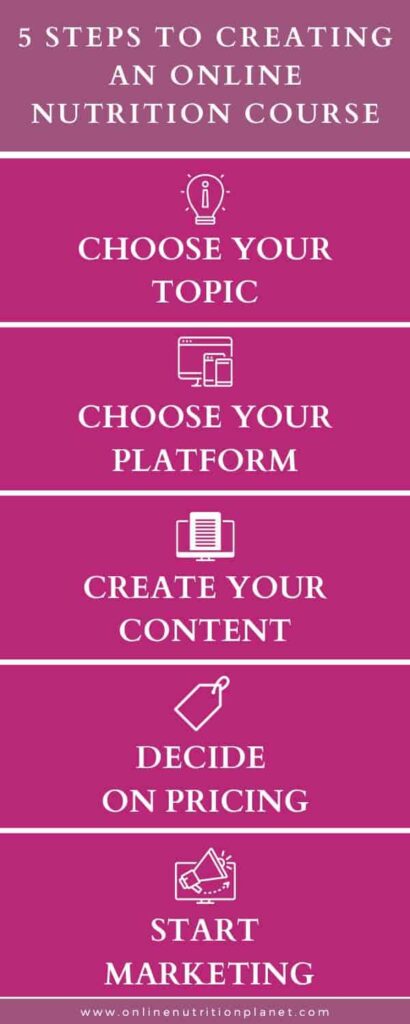Online courses saw a massive boom during the pandemic, and many believe that the online learning experience is here to stay. An online course is not only a way to add credibility to your brand; a successful course is also an added source of passive income. As a nutrition expert, you might be thinking that creating a nutritional online class would be an excellent entrepreneurial move, and you may be wondering what you need to do to launch your signature course.
The five steps to creating an online nutrition course are:
- Choose your topic.
- Choose your platform.
- Create your content.
- Decide on pricing.
- Start marketing.
Creating an online course may seem challenging, but is actually quite easy with the right tools at your disposal. Below, we’ve developed a plan to guide you through what it takes to create an online nutrition class. Keep reading to learn what we discovered about how this process works.
Article Contents
How Do I Start a Nutrition Course?
What are the steps that outline how to create an online nutrition course? Is there an easy way to approach this task? As a nutritional expert considering creating an online course, you’ve actually already taken one of the first steps in accessing how you begin this process if you are reading this—research.
Gathering information or researching is the best way to start your journey toward setting up an online nutrition course. Ideally, you’ll want to first determine which course-building platforms will best suit your business goals.
What Platforms Are Best for Creating an Online Course?
There are two types of platforms to consider for building your online course:
- E-learning Marketplace – An e-learning marketplace is a site where you create and host your own course on a website where your class becomes a part of their catalog of courses. These sites are also known as online learning platforms. Udemy and SkillShare are popular examples of e-learning platforms. Most e-learning marketplaces are free or provided at a very low cost to get started and may take a share of your course sales.
- Course Creation Software – Also known as a learning management system, LMS. Choosing a platform from this category means that you will have more control over customizations, more content formats for building your course, and marketing tools. Examples of popular course creation software are Teachable and Thinkific. They are both free to get started, but there is a monthly fee to use this software.
The 5 Steps to Creating an Online Nutrition Course

Creating an online nutrition course requires planning, research, developing course content (written and visual), and choosing a course platform. Marketing and course pricing are also essential elements to consider in creating an online class.
Let’s have a more in-depth look at each of these steps so that you have a good foundation of information on which to build a great online nutrition course.
Choose a Topic for Your Online Nutrition Course
One of the first things you’ll need to ascertain is the topic of your nutrition course. You may know what information you’d like to present, or you may need help determining your subject matter; as a nutritionist, you most likely have an area or niche that is your specialty.
Using your expertise will go a long way in clarifying your specialty course topic. If you choose an area you are well-versed in, coming up with course content will be a breeze.
A search on Udemy, a platform that offers online classes, reveals a vast and diverse selection of nutrition courses. Here’s a sample of offerings:
- Introduction to Herbalism
- Essentials of Green Smoothies
- Nutrition Masterclass: Build Your Perfect Diet and Meal Plan
- Ketogenic Diet: Keto Nutrition Health Coach Certification
- Intermittent Fasting 101 – The Complete Course
This list reveals various popular courses in nutrition, from providing introductory courses about diet, cooking, and recipes to more advanced classes on acquiring specific nutrition certifications.
Checking out what courses are currently offered can help you determine current trends in nutrition courses and where you, as a nutrition expert, and your topic will fit into the overall picture. It is also very encouraging because it illustrates you don’t have to present complicated subject matter to get started.
Choose Your Online Course-Building Platform
Above, we covered basic information about the two categories of platforms available for building your nutrition course. However, if you’re still unsure as to which specific platform you should pick within these categories, take a closer look at some of the popular options we mentioned:
- Udemy – Udemy is a popular e-learning platform for getting started. Easily create your course on their site and engage with a massive online learning community; it is a great place to test the waters for your online class with very little investment. Udemy is free and takes a portion of your revenue in return for their services.
- SkillShare – SkillShare provides its instructors with a platform to create e-learning courses. Rather than sell individual courses, SkillShare sells subscriptions for all its content. Once your class has more than 25 students, you are eligible to be part of their royalty program, and you can also make money by gaining students through your Teacher Referral link. SkillShare is an easy platform to get started on and with minimal investment.
- Teachable – Teachable offers an all-in-one platform that manages everything from course creation to marketing to payment processing. There are three monthly payment plans, depending on your needs, starting at $39 a month or $29 annually. Teachable is a step-up from e-learning platforms, allowing for the opportunity to manage your online course effectively as a business venture with support and all in one place.
- Thinkific – Thinkific is also an all-in-one platform that is similar to Teachable. The platform manages all the aspects of running an online course. It is free to start, and its most basic plan is $49 a month.
Udemy and SkillShare offer a low-cost way to gain some experience in online teaching with an active learning community. Teachable and Thinkific are more advanced platforms that help you create, market, and financially manage your online course.
Things to Consider Before Choosing an Online Course Platform
However, before committing to any of these platforms, research what instructors and students are saying about the pros and cons of each site. Look for reviews regarding the following:
- Are there other costs associated with platform use—credit card processing fees, for example?
- How is the customer support system set up, and is it reliable?
- How do instructors and students feel about using the platform; is it intuitive?
- Are the design features up-to-date and visually attractive?
The platform you choose will also depend on a variety of personal factors. Some things you’ll want to consider are:
- Consider the initial investment. E-learning marketplace sites are less of an investment. Course creation software can require a fee to get started, and there are monthly payments.
- Do you have an existing following or audience? If you don’t, e-learning sites provide a ready-made audience. If you already have a robust online presence with a large following, course creation software can be an option.
- Are you ready to make a major commitment? If you are positive online courses are for you and your business, jumping in with creation software would be an excellent decision for you. If you aren’t sure, an e-learning platform would be a great way to test the waters and explore the possibilities.
Once you’ve looked at reviews from fellow instructors and students and have a good understanding of your business goals, narrowing down a choice should be easy-peasy, and you can move on to the next step!
Create Your Content
No matter which online course platform you choose, you’ll need to create course content; each platform will offer various ways to share your course information.
Start by creating a course outline or syllabus and map out how you’ll present the information, find the supporting material you need to fill out your course, decide how best to present it, and start creating your class.
Items to consider for course content include:
- Informational videos
- Worksheets
- PDFs
- Basic text
These online platforms make their revenue from the courses they offer, and it’s in their best interest to provide you with all the tools you need to make your course making the process of adding your content easy. If you have the bulk of the information you’d like to present prepped, this step is a piece of cake.
Price Your Course
Each platform is different when it comes to how much you can charge for your online course. Here’s some basic information about the platforms we’ve focused on above:
- There’s no figuring out how much to charge for a SkillShare course; it’s based on a subscription to the platform, and students have access to all the courses offered.
- Udemy has a pricing matrix and a FAQ section that helps determine how much you will charge for your course.
- Teachable has a guide to help you decide how to choose prices for your courses.
- Thinkific also has a helpful guide to help set your course prices.
With course creation software, you’ll need to consider a few factors before deciding how much you charge for your class:
- Is your subject matter broad or specific? As a general rule, the more specific the information, the more you can charge for it; students are paying for your expertise.
- How much time and money will you spend on marketing? If you are spending extra time and money on marketing, can you recoup this cost through the cost of your class?
- What are others in your niche charging for their course? Can students get a lower rate for the same information on other sites? Consider competitive pricing to attract students to your class.
- How much value does a student receive from taking your course? Is there a certification available for completing the course? Certifications add more value and justify higher course fees.
Sometimes the best way to answer questions is to just take someone else’s course. Try some online nutrition courses for weight loss to see what others are doing in their classes.
Start Marketing
One of the many advantages of e-learning platforms is that they have a ready-made student population; they market the site to funnel students to the site. However, you can boost your presence on course-creation platforms by targeting your niche audience as well. Course creation software will have marketing options built into the site, and you’ll be guided through marketing choices.
You can promote your online nutrition course—regardless of the online learning platform you choose—by:
- Starting a blog about your course
- Creating a social media presence
- Defining and strengthening your personal brand
- Use your email list to generate leads and conversions
- Create lead magnets to build your email lists
Whether you choose e-learning or course creation, the best way you can help market your course is to create a “buzz” about your brand and what it has to offer. You’ll also be working to establish yourself as an expert in the nutritional field.
Conclusion
In summary, creating an online nutrition course can be overwhelming. However, if you do your research and follow the five steps outlined above, getting your class up and running should be a streamlined and smooth process, and you’ll be set up with your online nutrition class before you know it!
(Not yet certified in nutrition? There are plenty of online nutrition degree programs for you to get started!)




